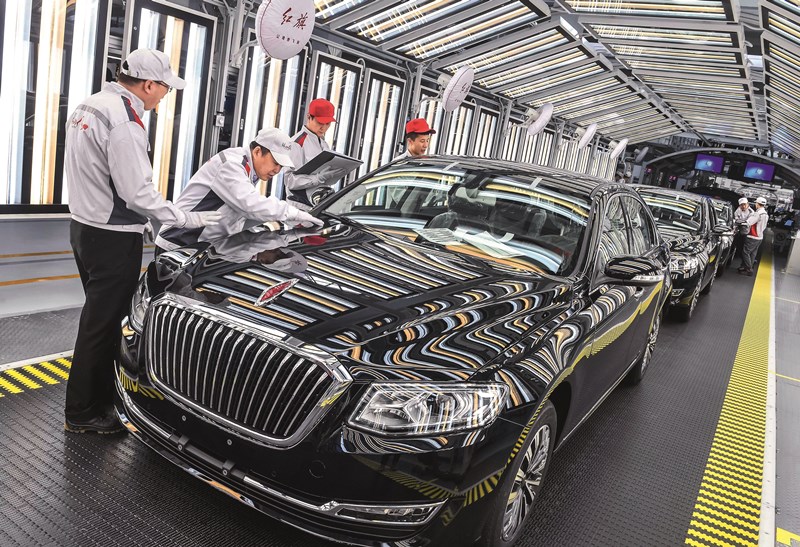Hope Over Challenge: China’s Economy in 2020

In 2019, China’s economic growth continued its slowing trend. Growth rates in the first three quarters were 6.4 percent, 6.2 percent and 6.0 percent, respectively. The growth rate of the whole year is estimated at 6.1 percent, a drop of 0.5 percentage points compared to that of 2018. However, the persistent growth in China, a major economy with some 1.4 billion people, still added about one trillion U.S. dollars to the global economy, indicating that China remains a key engine of the world economy.
This year, China will finish construction of a moderately prosperous society in all respects and fulfill the targets of the 13th Five-Year Plan (2016-2020). Currently, China is still in a pivotal stage for transforming growth model, improving economic structure and fostering new drivers of growth, and the influence of many domestic and foreign factors continues expanding. In this context, China’s economy will still face considerable downward pressure in 2020. According to the fourth national economic census released in 2019, the total volume of China’s GDP in 2018 rose by at least 2.1 percent over previous data. Based on this calculation, as long as China’s economic growth rate in 2020 reaches 5.8 percent, it can meet the target of completing the building of a moderately prosperous society in all respects, which requires its 2020 GDP to double that of 2010. If China’s economic growth rate does not decrease much in 2020 and its quality of development continues improving, healthy growth and simultaneous improvement of quality will be possible. In general, China’s economic growth rate in 2020 will fall slightly, and the country will face more challenges than in 2019. But many positive developments remain on the horizon.

April 24, 2019: Chinese smartphone producer OPPO releases its first 5G phone in Switzerland.Xinhua
First, the easing trade friction between China and the United States will contribute to a better external environment. After China and the United States reached a phase-one trade agreement, the two sides will reduce or lift tariffs on some products, which greatly improves global economic confidence. The development will boost the development of China’s export-oriented enterprises and, more importantly, improve economic and trade relations between the two countries. The signal of easing trade relations between the world’s two biggest economies will encourage traders globally, which is conducive to boosting global economic recovery and improving China’s external economic environment.
Second, stronger countercyclical measures will offset downward pressure. In 2020, China will maintain the guideline of making progress while maintaining stability. It will “keep employment, the financial sector, foreign trade, foreign and domestic investments, and expectations stable” to ensure the economy operates within an appropriate range. A major step for maintaining stability across these six aspects is to take stronger countercyclical measures including reduction of tax and administration fees and deeper supply-side reform of the financial sector. China is expected to reverse downward pressure through increasing public expenditures, maintaining capital adequacy and reducing business operating costs.
Third, the accelerated commercialization of cutting-edge technologies such as 5G will create new momentum for high-quality economic development. This year will welcome an acceleration of 5G commercialization in China, which will stimulate investment in infrastructure involving the latest information technology and stimulate consumption of 5G-related products. It will also fuel the development of emerging industries such as mobile terminals, pan-entertainment, industrial internet, remote medical care, and smart automobiles. Empowering traditional industries can accelerate their upgrading, which is conducive to cultivating new drivers and promoting high-quality development.
Fourth, ensuring the fulfillment of the two major tasks (targets of the 13th Five-Year Plan and completing the building of a moderately prosperous society in all respects) and the three “critical battles” (preventing and diffusing financial risks, performing targeted poverty alleviation and expanding pollution control) will support steady economic growth. In 2020, investment in infrastructure will increase healthily. More supporting policies and capital will reach impoverished areas, and the structure of income distribution will be adjusted to ensure middle- and low-earning groups see a boost in income. All of these measures are conducive to increasing effective investment, unleashing the potential of domestic markets and guaranteeing steady growth of consumption.
Fifth, deepening reform and opening-up measures will unleash market vitality. This year and the years to follow are expected to bring progress for reforms of China’s property rights system, factor market, finance, research system, state-owned enterprises and overall opening-up system, which will help transform the country’s institutional advantages into effective governance to improve the business environment and further unleash the vitality of the market to ultimately achieve steady economic growth.
The author is director of the Research Institute of Industrial Economy and Technology under the National Development and Reform Commission.